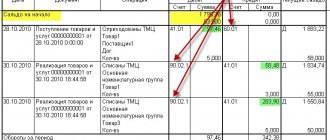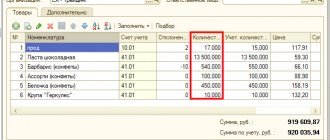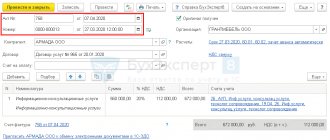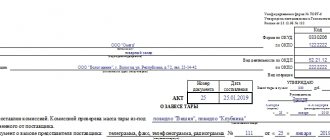Errors when filling out invoices are not uncommon. Both experienced accountants and novice specialists can perform them. The question arises how to fix the error. The legislation provides for the possibility of using adjustment invoices and making corrections to existing invoices, while the procedure for canceling this document is not prescribed anywhere. According to the Federal Tax Service, there is nothing complicated or requiring additional clarification in canceling invoices. Accountants can only rely on accepted legislative norms and established practice, which will be discussed further. It should be noted that the tax service does not object to its application (letter of the Federal Tax Service No. BS-18-6/499 dated April 30, 2015).
Canceled and zero invoice - what is the difference
Merchants can issue a zero invoice if they do not apply VAT (for example, simplifiers), at the request of the counterparty. However, the Tax Code does not provide for the obligation to issue zero invoices for them.
Read more about VAT under the simplified tax system in the material “VAT under the simplified tax system: in what cases to pay and how to take into account the tax in 2019-2020” .
The difference between nil and canceled invoices is the tax implications. So, if you register a zero invoice in the book of purchases or sales, there will be no consequences for the merchant. In the case of a canceled invoice, things are not so simple.
Changes in invoices from October 1
Legislators again adjusted the structure of the invoice (Resolution of the Government of the Russian Federation dated August 19, 2017 No. 981). The changes to invoices from October 2020 are as follows:
- a new column 1a “Product type code” has been added (1b - for adjustment invoices);
- the content of line 2a about the seller’s address has been adjusted;
- the title of column 11, dedicated to the details of the customs declaration (CD), has been edited;
- the scheme for working with line 8, intended to reflect the government contract identifier, has been clarified;
- The procedure for filling out an invoice has been added for certain cases (when it is issued by forwarders, customers or developers acquiring property rights on their own behalf, etc.).
You do not need to waste time searching for the form amended by Resolution No. 981 - the invoice from October 1, 2020 looks like this.
In the following sections we will dwell in more detail on the nuances of filling out the updated lines and columns of the invoice.
Why cancel an invoice?
Everyone makes mistakes, so errors in work sometimes occur. An absent-minded accountant may issue an invoice to the wrong buyer or make a mistake in his details. In any case, errors need to be corrected, but this is not always done in the same way.
For example, the original invoice contains information that does not correspond to reality, and this requires adjustments. The question immediately arises: how to cancel an invoice and are there other ways to correct it?
Cases when cancellation can be avoided, although the original invoice requires adjustments, are listed in clause 5.2 of Art. 169 of the Tax Code of the Russian Federation. This happens, for example, when the cost of goods (work, services) changes due to an adjustment in their price or quantity.
In this case, there are no questions about how to cancel the invoice, since the change in the tax obligations of the buyer and seller will be reflected in the books of purchases and sales based on the adjustment invoice. It is important to remember that it does not replace the original invoice, but only makes adjustments to it, that is, the existence of an adjustment invoice is possible only together with the original one.
Read about the position of the Ministry of Finance on the issue of using adjustment invoices in the material “Adjustment invoice is not for correcting errors .
There are few cases when you have to cancel the original invoice: if the seller issued a shipping invoice in error or made errors in the details that are significant for deducting VAT - in both situations, one of the parties will need to cancel the original invoice. Let's talk now about how to do this correctly.
Procedure for canceling invoices
You can generate a new document not only in case of an error in the primary documentation, you can also make changes to the adjustment account in the same way; in addition, the correction procedure may differ depending on the type of document.
Cancellation of an adjustment invoice
If any error or typo occurs, for example, arithmetic not in the primary, but already in the adjustment documentation, it is necessary, on the basis of clause 6 of Regulation 2 of Government Decree No. 1137, to make changes with justification. In this case, columns 16 and 1 are not applied to the adjustment.
If there is an error, the correction must be submitted again as a new version of the original document.
The procedure is as follows:
- when drawing up a new document, after some time the error is discovered again;
- then you need to contact the buyer and obtain consent;
- then make changes to the adjustment form based on the indicators;
- in this case, you need to correct the latest, not the primary version of the document.
Cancellation of an electronic invoice
With regard to electronic versions of invoices, the Ministry of Finance has certain requirements, in particular regarding the timing of their generation, indicated in the Procedure for issuing and generating invoices in electronic format using TKS using digital signature, approved. By Order of the Ministry of Finance No. 50n of 2011.
Important: the parties have the right to use such accounts by mutual agreement and the availability of appropriate equipment on both sides.
The next important point in such document flow is the period for issuing an invoice, which begins after receiving confirmation from the buyer of its delivery with a signature.
An important point is the method of correcting such a document - if an error is detected, the seller reissues a new document in place of the original one, that is, the initial document is canceled.
If the buyer finds an error, he has the right to send a notification to the seller with a proposal to make adjustments, to which he has the right not to respond.
Filling out an additional sheet of the Purchase Book when canceling an invoice.
Cancellation of a paper invoice
Before making changes, you need to decide which actions will be correct - adjustment or cancellation. Very often, specialists confuse actions and, instead of using the correct option, take erroneous actions.
So:
- The adjustment is applied when the cost of products or quantity changes; this is an appendix to the primary document and a carrier of all the data indicated in it with adjustments.
It should be understood that price changes - according to explanations, tax is the receipt of a discount from the seller, which affected the cost of the specified product.
Or, during the period of delivery of products, the seller does not know the final price for the shipped volumes due to its non-regulation, then the calculation is carried out taking into account the primary data.
However, in this case, the Ministry of Finance emphasizes that it is necessary to cancel the first invoice and create a new one, since the planned price should be used in the invoice, because the price does not change, but is simply calculated using quotes.
This means that the planned price simply needs to be applied, since there is a need to generate an invoice. Here you will learn how to correctly fill out an invoice journal.
- If the accountant made a technical error and, as a result, the invoice contains incorrect data, then a corrective version must be drawn up, that is, the original one is canceled. In this case, the document has independent data and is absolutely independent of the primary documentation, but at the same time it has a serial number and the date of compilation of the primary document.
Important: if there is an error in a paper document, the accountant is obliged to make a correction in the primary documentation as well, since there is an error.
Moreover, in certain cases regarding making corrections to the primary data, there are explanations in the Regulations of the Ministry of Finance No. 105 of 1983.
According to the statements of this document, corrections through one line are permissible only in the event of a technical error by the accountant, otherwise, if the document is correctly drawn up as of the current date, corrections are not made to the primary document, even if in the future there is a need for such an action.
How to properly cancel an invoice to a seller
Let's consider an example: Romashka LLC issued an invoice for shipment to Vasilek LLC in August and reflected it in the sales book for the 3rd quarter, and the next day it turned out that the goods were actually shipped to Kolosok LLC and The manager of this company did not immediately notice the error in the invoice received.
This circumstance did not in any way affect the final amount of tax in the sales book of Romashka LLC. All that was required was to issue a new invoice for Kolosok LLC and register it in the sales book and cancel the erroneous one.
To do this, the accountant of Romashka LLC once again reflected the data of the invoice erroneously issued to Vasilek LLC in the sales book (column 13a-19) with a minus sign (clause 3 of the rules for filling out an additional sheet of the sales book), and the invoice reflected the invoice to Kolosok LLC in the usual manner.
The procedure for registering invoices and actions for filling out sales books and purchase books (as well as additional sheets to them) are specified in the Rules for maintaining purchase books and sales books, approved. Decree of the Government of the Russian Federation dated December 26, 2011 No. 1137 on the forms and rules for filling out documents for VAT calculations.
If the erroneous invoice was discovered after the end of the third quarter, the accountant of Romashka LLC would have to draw up an additional sheet of the sales book and register the erroneously issued invoice in it (with a minus sign), then reflect the invoice addressed to LLC " Spikelet" for the same amount (clause 3 of the rules for filling out the sales book). At the same time, the total sales amounts of Romashka LLC would remain unchanged and the need for an updated declaration would not arise (clause 1 of Article 81 of the Tax Code of the Russian Federation, clause 2 of Appendix 2 to the order of the Federal Tax Service of Russia dated October 29, 2014 No. ММВ-7-3/ [email protected] ). However, in the situation under consideration, the data presented by Romashka LLC in Appendix 9 to the VAT return for the 3rd quarter will be incorrect and the tax authorities, if an error is discovered, will require an explanation (clause 3 of Article 88 of the Tax Code of the Russian Federation). You can prevent the tax authorities’ request by generating an updated VAT return for the 3rd quarter, adding Appendix 1 to Section 9 “Information from additional sheets of the sales book.”
For additional information, see the material “How to submit an electronic book of purchases and sales for tax purposes .
If the accountant of Romashka LLC forgot to reflect the invoice issued to Kolosok LLC in the sales book, and managed to cancel the invoice addressed to Vasilek LLC, he would have to submit an amendment, since this would underestimate the final sales ( Clause 1 of Article 81 of the Tax Code, Clause 5 of the rules for filling out the additional list of the sales book, letter of the Federal Tax Service dated November 5, 2014 No. GD-4-3/ [email protected] ).
Regulatory regulation
The formation of an invoice as a whole is carried out by the supplier to present it to the end consumer for added value, therefore, if there is a need to correct it, this action is charged to the seller.
A canceled (corrected) invoice is a new formation of a document issued by the seller, which is used as independent documentation without the primary one.
If the seller cancels his own copy, for example, an error was discovered in it, the buyer who received the same copy to pay VAT must also cancel the entry in the Purchase Book, which every buyer who is a VAT payer must have.
You can see the differences between adjustment and corrected invoices in this video:
The procedure for making such a cancellation in the documentation of both the seller and the buyer is contained in the rules for filling them out and approved by Decree of the Government of the Russian Federation No. 1137 of 2011.
Based on paragraph 1 of Art. 81 of the Tax Code of the Russian Federation for the period with the resulting cancellation, it is necessary to submit an updated declaration.
The template for making changes by the seller is indicated in paragraphs. 3 clause 11 of the Rules for maintaining the sales book, for the buyer in clause 4 of the Rules for maintaining the purchase book.
After making changes to the declaration, it is necessary to perform a recalculation in the same period on the basis of Art. 54 Tax Code of the Russian Federation.
Tax Code of the Russian Federation Article 54. General issues of calculating the tax base
1. Taxpaying organizations calculate the tax base at the end of each tax period on the basis of data from accounting registers and (or) on the basis of other documented data on objects subject to taxation or related to taxation. If errors (distortions) are detected in the calculation of the tax base relating to previous tax (reporting) periods in the current tax (reporting) period, the tax base and tax amount are recalculated for the period in which these errors (distortions) were made. If it is impossible to determine the period of errors (distortions), the tax base and tax amount are recalculated for the tax (reporting) period in which the errors (distortions) were identified. The taxpayer has the right to recalculate the tax base and the amount of tax for the tax (reporting) period in which errors (distortions) relating to previous tax (reporting) periods were identified, also in cases where the errors (distortions) led to excessive payment of tax . 2. Individual entrepreneurs, notaries engaged in private practice, lawyers who have established law offices, calculate the tax base at the end of each tax period on the basis of accounting data for income and expenses and business transactions in the manner determined by the Ministry of Finance of the Russian Federation. 3. Other taxpayers - individuals calculate the tax base on the basis of information received in established cases from organizations and (or) individuals about the amounts of income paid to them, about the objects of taxation, as well as data from their own accounting of income received, objects of taxation carried out according to arbitrary forms . 4. The rules provided for in paragraphs 1 and 2 of this article also apply to tax agents. 5. In the cases provided for by this Code, tax authorities calculate the tax base at the end of each tax period based on the data available to them. 6. The provisions on recalculation of the tax base provided for in paragraph 1 of this article are also applied when recalculating the base for calculating insurance premiums, unless otherwise provided by Chapter 34 of this Code.
Grounds for cancellation
Account cancellation can occur for certain reasons, of which there are not many:
- the address of the wrong buyer is indicated on the invoice;
- There was a typo in the recipient's details, which will ultimately affect the amount of VAT deduction. Here you will find out when and how VAT refunds from the budget are carried out;
- the transaction did not take place and the invoice is not current.
Important: cancellation does not apply if the situation is related to those indicated in Art. 169 of the Tax Code of the Russian Federation, in this case the primary documentation is adjusted, taken into account by both parties only as an annex to the original one.
Adjustment situations include changes in the value or quantity of goods when the cancellation of the previous document is not expected.
Important: the seller must adjust the invoice no later than 5 days from the date of provision of the primary document. In this case, adjustments can only be made by mutual agreement of the parties, as confirmed by written agreements.
In this case, as already mentioned, the revocation of an incorrectly formed document must be performed by both parties.
If the buyer disagrees with the terms of delivery, then a return is issued with a subsequent change in the terms of cooperation and the operation is carried out again.
Explanations from the Ministry of Finance regarding error correction
As the Ministry of Finance noted in Letter No. 03-07-11/359 of 2010, corrections should be made to copies of the accounts of both parties, and no special rules are provided for the procedure.
However, the Federal Tax Service in its Letter No. 03-1-03/1924 of 2008 indicates recommendations regarding the regulations for making changes to accounts. The following points are relevant to such explanations:
- when making adjustments, incorrect indicators in columns/lines must be crossed out;
- in the free column you should indicate “Corrected” with a link to the corresponding entry;
- the new entry is certified by the signature of the manager and the stamp of the enterprise.
Due to the lack of special explanations regarding the procedure for making corrections, the Federal Tax Service recommends the use of certain points that, in its opinion, are the only correct ones, in particular, correcting errors by generating a new document.
However, the Ministry of Finance has the opposite opinion in this regard, and indicates that replacing documentation is not acceptable.
Important: art. 21 of the Tax Code of the Russian Federation points to the fact that the mandatory use of the new document is not necessary, but there is no prohibition on its use in the Rules.
An example of filling out an electronic invoice.
Judicial practice in this case also takes the side of the taxpayer, who made the correction by replacing the document with a new one, on the basis that the legislative documents completely do not prohibit such actions, and there are no specific instructions regarding another option.
Cancellation of an invoice by the buyer
In the considered example, for Vasilek LLC and Kolosok LLC, the cancellation of an erroneous invoice did not create additional problems, since no entries were made in the purchase book based on this invoice. However, situations are different: suppose an erroneous invoice addressed to Vasilek LLC, along with a lot of other invoices, ended up in the accounting department of Kolosok LLC, after which the absent-minded accountant of Kolosok LLC, reflecting the received invoices in the purchase book, mistakenly entered amounts from all invoices into the purchase ledger. As a result, the tax deduction for the 3rd quarter turned out to be overstated, which was discovered after filing the return.
In this case, the buyer, Kolosok LLC, will have to cancel the invoice and correct the purchase book. To do this, the accountant needs to draw up an additional sheet to the purchase book for the 3rd quarter, in which in gr. Enter items 15 and 16 of the erroneous invoice with a minus sign (clause 5 of the rules for filling out the additional sheet of the purchase book). Then you need to submit an update, having previously paid additional tax and penalties in order to avoid a fine (Clause 1, Article 81 of the Tax Code, Clause 6 of the rules for filling out the additional list of the purchase book).
Accountant's Directory
07/27/2018 Contents To cancel an invoice, the following actions must be completed: 1) The seller must issue a written message to the buyer that he is canceling the invoice.
The question immediately arises: how to cancel an invoice and are there other ways to correct it? Cases where cancellation can be avoided, although the original invoice requires adjustments, are listed in paragraph.
2) The seller registers the cancellation of the invoice in the sales book 3) The buyer registers the cancellation of the invoice in the purchase book The law does not define the procedure for canceling the invoice.
At the same time, the need to cancel an invoice arises in practice quite often. For example, the contractor sent the customer a certificate of completion and issued an invoice in March. But the customer did not accept the work performed and demanded that the deficiencies be corrected. The customer signed the deed in November. In the above situation, the invoice issued in March is not issued correctly.
The invoice should be issued only in November, after the customer has accepted the work. Such an incorrectly issued invoice should be cancelled.
But, as I already noted, the procedure for canceling an invoice has not been established. Thus, Decree of the Government of the Russian Federation dated December 26, 2011 N 1137 approved the Forms and rules for filling out (maintaining) documents used in calculations of value added tax. This document defines the procedure for correcting an invoice.
However, when correcting an invoice, its number or date cannot be changed.
Accordingly, in the situation under consideration, correction of the invoice is impossible.
The same document talks about the cancellation of entries in the sales book and purchase book.
How to cancel erroneous invoices in accounting if the VAT return has already been submitted
January 20, 2020 VAT reporting has already been submitted, but suddenly you discovered that one of the sales invoices was entered twice, and the paper invoice received from the supplier indicated a later date than you indicated when entering.
How to remove the 1C: Accounting 8 program ed. from the information base.
3.0 unnecessary invoices after the end of the reporting campaign?
If, after submitting the declaration, the taxpayer discovers that some information was not reflected in the declaration (not fully reflected) or identifies errors, then, according to paragraph 1 of Article 81 of the Tax Code of the Russian Federation, he:
- is obliged to make changes to the tax return and submit an updated return if errors (distortions) led to an understatement of tax;
- has the right to make changes to the declaration and submit an updated declaration if errors (distortions) did not lead to an understatement of the amount of tax payable.
If the detected errors or distortions relate to previous tax (reporting) periods, then the tax base and tax amount are recalculated for the period in which the specified errors (distortions) were made (para.
2 p. 1 art. 54 of the Tax Code of the Russian Federation). This is a general rule. But the taxpayer has the right to recalculate the tax base and the amount of tax liabilities even during the period when errors are identified.
This is possible in two cases:
- if such errors (distortions) led to excessive payment of tax (paragraph 2, paragraph 1, article 54 of the Tax Code of the Russian Federation).
- if it is impossible to determine the period of commission of these errors (distortions);
But applying these rules,
Results
If a merchant has recorded erroneous information in the purchase or sales book, he will need to cancel the invoice and correct the entries in these books.
The actions in this case depend on the period in which the invoice requiring cancellation occurred. Entries are made in the books themselves or in additional sheets to them. In any case, the data in the book of purchases and sales (or additional lists) for the canceled invoice is always given with a minus sign. You can find more complete information on the topic in ConsultantPlus. Full and free access to the system for 2 days.
Adjustment or corrected invoice in 2020: how not to miss?
Resolution No. 1137, upon receipt of a corrected invoice after the end of the current tax period, the entry on the invoice is canceled in an additional sheet of the purchase book for the tax period in which the invoice was registered before the corrections were made to it (clause 4 of the Rules for maintaining the book purchases, approved by Resolution No. 1137). Despite the fact that these norms of Decree No. 1137 relate the procedure for correcting the sales book and (or) purchase book only to making corrections to invoices, the use of additional sheets of the purchase book and (or) sales book is prescribed in relation to any changes to the sales book and ( or) purchase books for expired tax periods (letters of the Federal Tax Service of Russia dated 09/06/2006 No. MM-6-03/, dated 04/30/2015 No. BS-18-6/). The data from such additional sheets is used to make changes to the VAT tax return (clause
Should line 8 be filled in if there is no identifier?
Line 8 in the invoice appeared quite recently (Resolution of the Government of the Russian Federation dated May 25, 2017 No. 625). Since July 2020, it must reflect the identifier:
- government contract for the supply of goods (provision of services, performance of work);
- agreement (agreement) on the provision of investments, subsidies, and contributions to the authorized capital from the federal budget.
In Resolution No. 981, the scheme for filling out line No. 8 is clarified:
- The line must contain information about the government contract identifier, if available (it is written in the contract itself or indicated in the Unified Information System).
- It contains a dash if there is no identifier.
The following materials will introduce you to the nuances of preparing invoices:
Right to deduct VAT
Based on invoices (adjustment invoices) drawn up in accordance with the rules of tax legislation, as well as upon fulfillment of other conditions listed in Articles 171 and 172 of the Tax Code of the Russian Federation, an organization can accept VAT for deduction (clause 2 of Article 169 Tax Code of the Russian Federation).
Tax inspectorates do not have the right to refuse an organization a deduction if:
1) the invoice or adjustment invoice contains all the mandatory details provided for in paragraph 5 or 5.1 and 5.2 of Article 169 of the Tax Code of the Russian Federation, and is signed by the persons specified in paragraph 6 of Article 169 of the Tax Code of the Russian Federation;
2) the invoice (adjustment invoice) contains additional details or information (letter of the Ministry of Finance of Russia dated February 9, 2012 No. 03-07-15/17, Federal Tax Service of Russia dated July 18, 2012 No. ED-4-3/ 11915);
3) the invoice is filled out in a combined way (some of the details are filled in manually, and some on the computer (clause 2 of Section II of Appendix 4 to the Decree of the Government of the Russian Federation of December 26, 2011 No. 1137);
4) the invoice, including the adjustment invoice, contains errors that do not interfere with the identification of:
- seller (performer) or buyer (customer);
- name and cost of goods sold (work performed, services rendered, property rights transferred);
- tax rate and VAT amount charged to the buyer.
This follows from the provisions of paragraph 2 of Article 169 of the Tax Code of the Russian Federation.












